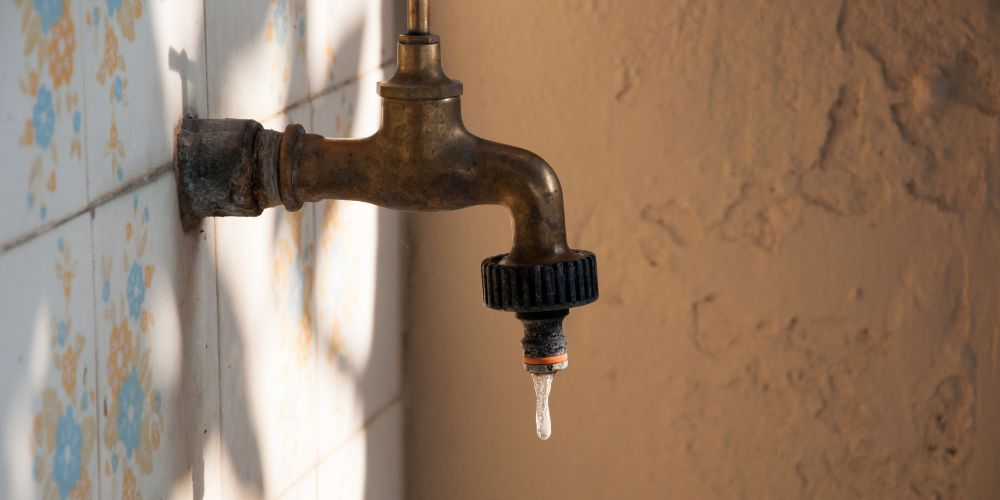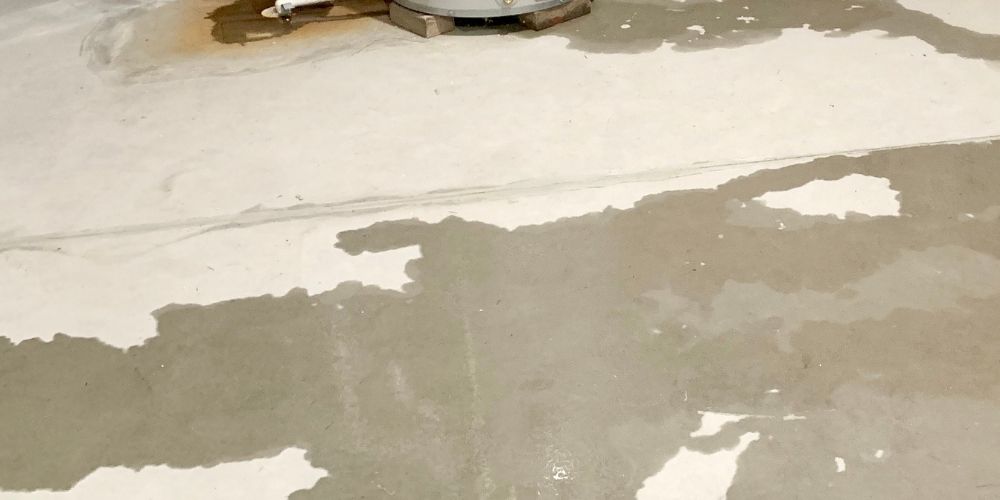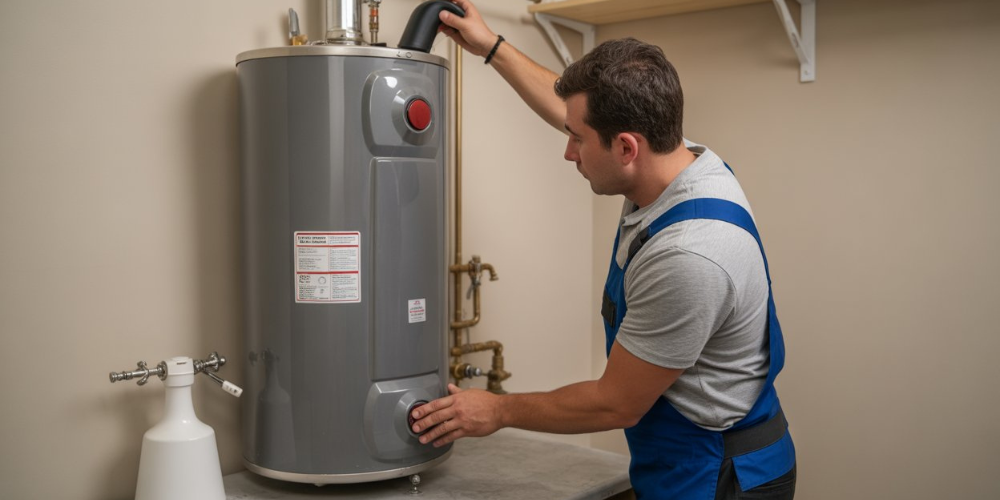The Environmental Protection Agency (EPA) reports that household leaks can waste an average of 180 gallons of water per week, totaling 9,400 gallons yearly. That’s equivalent to over 300 loads of laundry.
Water leaks in your home can be sneaky and costly, causing hidden damage that often goes unnoticed until it’s too late. While water stains on ceilings, walls, or floors are clear signs, hidden leaks can be trickier to spot.
But don’t worry—detecting water leaks doesn’t have to be a daunting task. With the right knowledge and a few simple techniques, you can uncover these hidden troublemakers before they escalate into major issues.
Here are eight ways to detect hidden leaks before calling a repair service. Leaks can occur anywhere, from burst pipes to loose connections under floors. Acting fast is crucial, and knowing how to find leaks is the first step.
8 Signs to Detect Water Leaks in Your Home
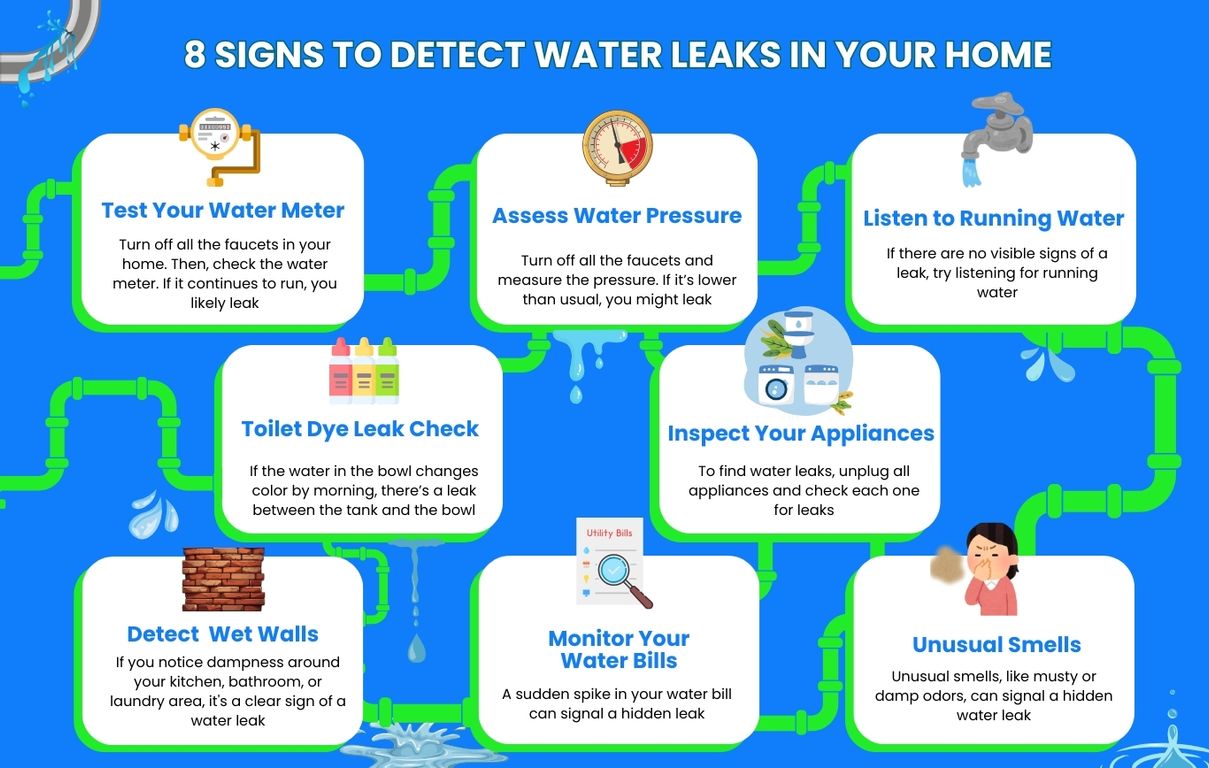
1. Test Your Water Meter:
If you don’t notice a change immediately, recheck the meter after a few hours. If the reading has shifted, it could indicate a slow leak.
2. Assess Water Pressure:
Find hidden water leaks by checking your home’s water pressure. Turn off all the faucets and measure the pressure. If it’s lower than usual, you might leak.
3. Listen to Running Water:
If there are no visible signs of a leak, try listening for running water. Leaks can sometimes be heard through walls or floors.
4. Inspect Your Appliances:
To find water leaks, unplug all appliances and check each one for leaks. For your water heater, inspect where water enters and exits the tank, and check the pressure relief valve for leaks. If you see a drip from the drain valve at the bottom, temporarily cap it with a garden hose cap and plan to replace the valve soon.
5. Toilet Dye Leak Check
To check for a toilet leak, add food coloring to the tank and leave it overnight. If the water in the bowl changes color by morning, there’s a leak between the tank and the bowl.
Toilets often leak due to their connections and location. Inspect the ceiling below for stains and measure the distance from the toilet to any wet spots to locate the source of the leak.
7. Monitor Your Water Bills
A sudden spike in your water bill can signal a hidden leak. Compare recent bills to previous months—if you see a steady increase without changes in usage, you might leak. Since underground pipes might not show visible signs, it’s best to have a professional plumber check for any hidden issues.
8. Detect Water Drips or Wet Walls
If you notice dampness around your kitchen, bathroom, or laundry area, it’s a clear sign of a water leak. Leaks not only cause unsightly messes but can also lead to mold growth and structural damage if ignored.
That’s why leak detection and repair are essential to prevent long-term issues. Addressing leaks quickly will save you from costly repairs and protect your home from further damage.
8. Unusual Smells
Unusual smells, like musty or damp odors, can signal a hidden water leak. These smells often come from mold or mildew growing in moist areas. If you notice these odors, check for leaks behind walls, under floors, or around pipes to address the issue early and prevent further damage.
Detecting Leaks: Inside vs. Outside
Once you’ve confirmed you have a leak, the next step is to determine if it’s inside or outside your home.
Start by finding your main shut-off valve and turning off the water. This valve is usually located in the basement, garage, or just outside near an outdoor faucet.
Check the leak indicator or the meter reading while ensuring no water is used. If the indicator stops moving or the meter reading stays the same, the leak is inside your house. If the indicator continues to move or the reading changes, the leak is outside, between the meter and your home. If you can’t pinpoint the leak, it’s best to call a professional plumber for help.
How to Fix Common Water Leaks?
- Dripping Faucet

Hearing a constant drip from your faucet? Leaky taps are often caused by wear and tear or debris buildup.
To fix it, start by turning off the water supply. Then, open the faucet and check the washer. Clean away any debris with a cloth. If the faucet is damaged, you might need to replace it.
- Leaking Plastic Pipe
To fix a leaking water pipe, first locate the source of the leak. Turn off the water supply and replace the damaged pipe. For a temporary fix, you can use tape and epoxy. However, if the damage is severe, call a plumber right away. In the meantime, use rubber and a hose clamp to stop the leak until help arrives temporarily.
- Leaking Showerhead
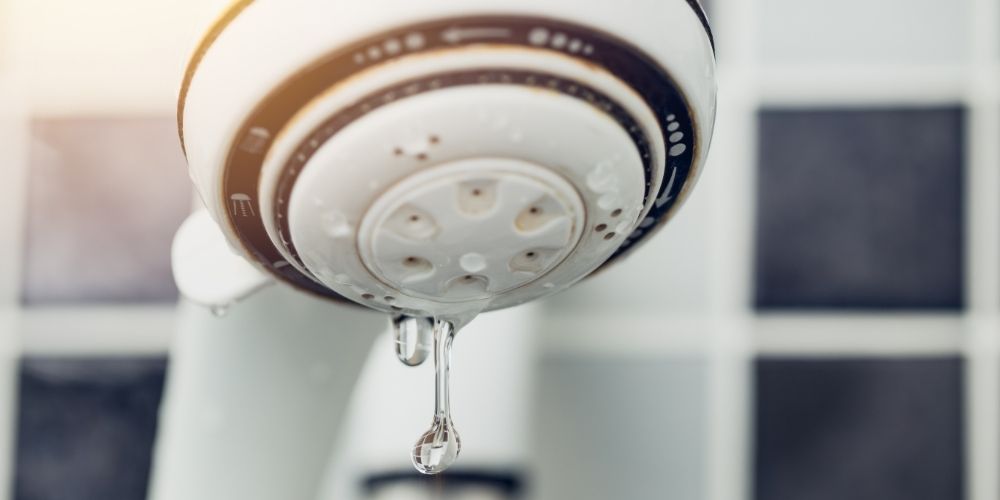
Start by turning off the water supply. Next, remove the handle cap, handle, and faceplate. If your shower has one handle, take out the locking clip and cartridge. Replace the cartridge and any other needed parts. Turn the water supply back on, open the tap, and check if the leak is fixed.
- Leaking Toilet Base
Dealing with a leaking toilet can be frustrating, but it’s often an easy fix. If you notice water leaking from the base after flushing, the problem might be a worn-out rubber seal or loose bolts.
To fix it, you’ll need a new wax ring and an adjustable wrench to tighten or replace the bolts. However, it’s usually best to call a professional plumber to handle the repair for you.
- Water Heater Tank
If your water heater starts to leak, it’s crucial to act quickly to avoid a major issue. Even a small leak can lead to a burst tank, so regular maintenance is essential.
To spot leaks, check for condensation around the tank. Leaks might also occur at the top or bottom. Top leaks often come from faulty inlet or outlet connections, while bottom leaks usually result from a damaged drain valve or the tank itself. Identifying the leak’s location can help determine the needed repairs.
Regularly check the pressure valve and flush the tank annually to keep it in good condition.
Wrapping It Up
Catching water leaks early is crucial to avoiding major damage and hefty repair bills. You can spot leaks before they escalate by staying alert for signs like strange smells, damp patches, or unusual water meter readings. For simple fixes, such as addressing a leaking toilet or checking pipes, a bit of DIY might do the trick.
However, for more stubborn leaks or complex issues, don’t hesitate to reach out to a professional. At PlumbSmart, we’re here to help with all your leak detection and repair needs. Contact us today to get expert assistance and keep your home safe and dry. Your peace of mind is just a call away!


